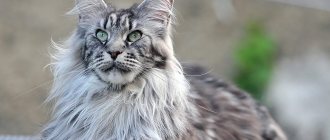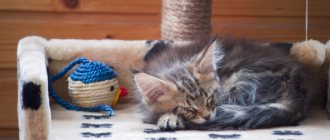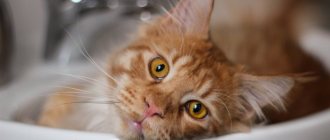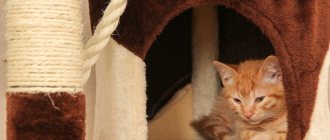What documents for a kitten must be given when purchasing it?
A purebred kitten must have documents confirming that it has the declared breed and the declared level of health. It is advisable that upon purchase you are given a veterinary passport, one copy of the contract and a metric/pedigree or their equivalent (for American systems). If they give you a metric, then you don’t need to ask for a pedigree, and, therefore, vice versa: the pedigree is given without a metric. Ideally, the breeder should give you one of these two documents, regardless of whether you are taking a kitten for castration or breeding.
ATTENTION!!!
Conscientious breeders do not sell kittens with documents for one amount, and without documents for another (cheaper). In any system, the litter is registered as a whole, and documents are issued for all kittens at the same time; a conscientious breeder cannot have kittens without documents in principle!
The preparation of documents for a litter in the club/system itself is quite inexpensive, but to obtain them you must strictly follow the rules of the system. Pedigree kittens with documents are expensive not because they have documents (papers), but because these “pieces of paper” guarantee the breed of the animal and its physical and mental health (to a certain extent). The documents also allow you to find a breeder, get advice, help, and even return the kitten and the money for it if problems arise.
Kitten veterinary passport
The veterinary passport indicates the name, gender, breed of the cat, its date of birth, the name of the owner and/or breeder. But the most important thing is that the passport must contain vaccination records with a special sticker, a veterinary clinic stamp and a doctor’s signature.
Veterinary passports come in different designs. The standard passport is blue with blue security inscriptions “pet”, but if they give you a passport of a different type, it’s okay. Different regions have different requirements, if anything happens, your veterinarian will make you a new correct passport and offer to keep the old one, just in case.
It is important to understand that every purebred kitten must have a veterinary passport, but it does not in any way confirm its breed, since it is filled out by a veterinarian or breeder, and clubs and exhibition systems are authorized to guarantee the breed.
International veterinary passport
A veterinary passport is issued, as a rule, at a veterinary clinic when the first vaccination is given (in large nurseries this is done at home by a permanent veterinarian who provides medical care for all animals in a given nursery). In the veterinary passport, in addition to basic data about the kitten (name, breed, gender, date of birth, color), there must be notes on all vaccinations given to this animal (date of vaccination, vaccine), in addition, it contains data on deworming (deworming ). Having a veterinary passport is required if you plan to attend exhibitions or travel somewhere with your pet. EXAMPLE OF PASSPORT.
Metrica\kitten slip (“kitty”)
This is the kitten’s birth certificate, which is issued upon its activation in the club/system. The metric indicates the kitten's name, its breed, gender, color, date of birth; names and colors of the kitten's parents; name of the breeder, etc. The document must have the emblem of the system to which the kitten belongs.
Also, the metric of the European system must bear the seal of the club that issued it, and the signature of the responsible club functionary who activated the kittens, so that in the future it can be exchanged for a pedigree.
In American systems, based on the metric (slip), a kitten is registered and a pedigree is ordered at the central office.
A European breeder may refuse to give kittens for castration, but he is obliged to at least show it to you. And it’s better to ask her to give her back, the club still knows that the kitten is for castration and will not give you the pedigree just like that.
In American systems, such problems do not arise, since all breeding restrictions are indicated when registering a litter.
Agreement
An agreement between the breeder and the owner is concluded when selling or purchasing a purebred kitten, to clarify some agreements between them. For free.
The main cost of a purebred kitten sold depends on the quality, uniqueness of the breed and origin. Each breeder sets the cost of a kitten (the fruit of his breeding work), but the average price in quality nurseries starts from about 5-10-25 thousand rubles. (castrato) and 40-50-100 thousand rubles. (show kitten for breeding work and exhibitions). In principle, a thoroughbred and high-quality producer cannot be cheap!
Before you buy an animal on the market or through dubious advertisements, count the amount you will pay for the treatment of a sick kitten bought from someone unknown, and if it dies in the first weeks, also count your nerves and the tears shed by your family. Is it worth it? Believe me, not all kittens in nurseries are used for breeding, and therefore for a small amount you can find a good purebred kitten from a good breeder, of which there are plenty throughout Russia and beyond, you just need to be more attentive and thorough in preparing for the purchase of your kitten and slowly search.
Rate and share!
Pedigree (“roduha”) of the kitten
The pedigree indicates several generations (3-5) of your kitten’s ancestors (their nicknames, colors and pedigree numbers). The pedigree must contain the emblem of the association (system), the name of the club, nursery, the name of the breeder and the name of the owner of the kitten, information about the kitten itself.
Be careful: in the pedigree, in the “owner” column, your name must be indicated, not the name of the breeder! To do this, you need to either obtain a pedigree yourself, or agree in advance with the breeder on its registration.
In the European system, the pedigree must have a number, the seal of the club and the signature of its leader. In American ones, only the number is indicated, since the pedigree is issued by the system.
If the kitten is to be castrated, then in the European system they may give you a pedigree without a number or with a “pet” stamp, or not issue it at all, but again it would be better to negotiate so that they give it.
If you yourself draw up a pedigree based on metrics in a club specified by the breeder, then you must request it before the kitten turns one year old. This applies only to European systems; in American systems, the owner can request a pedigree based on the breeder slip at any time if the cat has been registered in the system. In American systems, pedigrees are informational in nature, and the pedigree of a cat is confirmed by registering the litter and the cat itself in the system in accordance with its rules.
However, you will not need a pedigree if you do not engage in breeding.
How to take a cat abroad
International veterinary passport
If you are planning a trip abroad, however, you are not going to part with your cat, because you are worried that the animal will take separation from you too painfully, theoretically you can take the cat with you. But in practice, in order to implement such an idea, you will have to document preparation for this step.
- First of all, check with the embassy of the country where you are traveling about the rules for importing animals, and inquire about the transportation rules of the carrier company with which you plan to deal. This will allow you to navigate the documents that may be required of you.
- 2 months before the date of departure, contact the local veterinary clinic (public, not private) to conduct a full examination of the animal, give the animal 2 rabies vaccinations (the minimum interval between them should be 10 days), carry out the microchipping procedure and register the animal if It doesn’t exist yet, an international veterinary passport, where data on the animal’s vaccination will be entered.
- 3 days before your departure date, obtain a certificate from the clinic’s chief veterinarian about the cat’s health condition. Please note that such a certificate must contain a note about the epidemiological situation in the area where the cat lived over the past few months.
- To travel with an animal, purchase a special container for it, or a convenient carrying bag (read about how to choose one here) that would correspond to the size of the animal.
- Within the time limits specified in the rules for importing animals, which were provided to you by the embassy of the country you are traveling to, carry out treatment for external and internal parasites. It is advisable to use the same means specified in these rules.
- Contact the veterinary committee for a certificate stating that your cat is not a valuable breeding representative of the breed - this will help you avoid bureaucratic quibbles at customs. Issuance of the certificate takes up to 2 weeks.
- You will receive the animal's personal number from the Ministry of Agriculture - the procedure takes several days.
- In the documents of the border service of the airport or train station, check whether the animal's registration number is entered into the database.
- Provide a certificate from a veterinarian issued to you at your place of residence to the veterinarian at the station or airport no earlier than one day before your departure and receive a boarding pass for your animal.
Video about documents for cats:
Certificate of registration of the cat in the system
In American exhibition systems, the main document of a cat is a registration form, which indicates the registration number of the animal. This document certifies the cat’s membership in the relevant system, and, consequently, the right to receive titles and pedigrees for it at the central office of the organization, and to register the litters received from it.
In addition to the number, the form indicates the name of the cat, its breed, color, its parents, date of birth, name of the owner and breeder of the animal; the logo of the system and the signature of its secretary (facsimile).
In fact, the registration certificate is also the system's legal proof of cat ownership. Therefore, usually, such a certificate is issued to the new owners of the cat, after purchasing it from the breeder, based on the received metrics. If the breeder registered the cat before the sale, then he is required to issue another document - a transfer.
What is the difference between a purebred Maine Coon and a purebred one? Availability of documents?
As a rule, a purebred animal is understood as an animal with documents, a representative of the breed, not a mestizo. A purebred Maine Coon is a worthy representative of the breed, meeting the Maine Coon standard, a high-quality Maine Coon, suitable for breeding and exhibitions and receiving high marks from experts.
Even excellent producers have unsuccessful kittens, purebred and healthy, but not purebred. As a rule, such kittens become pets (pets), although it is not always possible to recognize this at an early age. It happens that a nondescript kitten grows into a purebred animal, and sometimes vice versa. Buying animals for breeding is always a certain risk. About the breed Choosing a kitten Documents Property Nutrition Health Contents Education Care Neutered Cattery Breeding Exhibitions
Transfer to own a cat
A transfer is a document confirming the transfer of a cat from one owner to another. It is not required if, when purchasing a kitten, a pedigree was not made or registration in the system was completed, and also if, when registering one of these documents, the name of the new owner was already known and entered in the appropriate columns.
A de jure transfer for owning a cat exists in all exhibition systems, but in practice in European systems they prefer to issue kitten buyers with birth certificates so that they independently draw up pedigrees for themselves, and there are no official transfer forms. In these systems, transfers are issued by clubs only in cases of urgent need or if the new owner (not mentioned in the pedigree) wishes to register the cat in American associations. In the latter, transfers are more popular, although breeders also try to do without them.
In addition, in some American systems it is possible to rent a cat for a certain period. That is, the cat becomes yours and in the documents for the rental period you are indicated everywhere as its owner and are fully responsible for it.
Is it possible to buy a pedigree for a cat?
Many owners believe that breed clubs sell documents. A pedigree can be purchased by anyone who wants their pet to have documentary evidence of its thoroughbred. This is wrong. It is usually impossible to buy a pedigree without a meter or examination and conclusion of an expert commission. However, unscrupulous clubs sometimes neglect this rule. Fortunately, this does not occur often and is suppressed in every possible way in felinological systems. Future owners of a purebred kitten should think in advance about the need for a pedigree. Saving when buying a pet can lead to the fact that it is simply impossible to legally obtain a pedigree for a cat without documents. Don't try to buy paper. Just as you should not abuse obtaining “certificates of conformity” - a cat with an unconfirmed line of genetics is unpredictable in breeding. In addition, the offspring of such an animal may be seriously ill.
Veterinary certificate form No. 1
If a kitten comes to you from another region, it must have veterinary form (certificate) No. 1 (transportation permit). It indicates the name, gender and age of the kitten, its breed; Breeder's name; There is also a doctor’s signature and a clinic stamp. If there is no such certificate or it was not given to you, then it’s okay, but if there is one, it means that the breeder did everything correctly and according to the law.
ATTENTION! If a kitten does not have documents, then it is not considered a purebred! Participation in breeding without a pedigree is impossible!
0
Why do they issue documents for animals?
Having documents for a cat is a prerequisite for participation in exhibition events. If a pet is bought for the soul and does not plan to receive honorary titles, then this is not a reason to refuse official registration. A basic set of documentation is necessary not only for exhibitions, but also for:
- Border crossing
. Moving to another country or another city within the country will be impossible without providing the required papers for a pet.
- Solutions to controversial issues
that arise when a pet is kidnapped or lost. Trying to prove ownership in court with words alone is a lost cause.
- Proof of breeding value
. The desire to breed a breed can come spontaneously. If everything is prepared in advance, you won’t have to look for where to buy documents for a cat. You will also have to deal with mandatory paperwork after the birth of kittens.
Before purchasing, familiarize yourself with what all the necessary papers look like. This will eliminate the subsequent search for information on how to prepare documents for a kitten yourself.
Breeding purebred cats - main stages, rules
Have you purchased or are you planning to purchase a purebred kitten or want to breed? Don't know where to start? This article contains the main stages and rules of breeding.Choosing a kitten
If you are buying a kitten for breeding, you must approach the choice of a kitten completely differently than when choosing just a pet. Your pet must be healthy and you personally like it, that’s enough. A kitten for breeding is a completely different matter.
Before you buy a kitten for breeding, you should first get to know the chosen breed in as much detail as possible, carefully study the characteristics of the breed, find out the advantages and disadvantages, and most importantly, see with your own eyes as many cats of this breed as possible. Your choice should not be random, but conscious
— You must understand what the breed advantages and disadvantages of the kitten you have chosen are, what grades and titles the kitten can receive at exhibitions, and what kind of offspring will be born from this kitten when he/she becomes an adult.
KLK "Moscow" strongly recommends that both buyers and breeders enter into a written contract for the purchase and sale of a kitten, regardless of the price of the kitten and the purpose of the purchase - for breeding or as a pet. The agreement will allow you to avoid mutual claims in the future. If a kitten is purchased for breeding, a written purchase and sale agreement is required! A sample contract for the sale and purchase of a kitten is available on the Club Documents page
What class should a kitten belong to - show, breed, pet... >>>>>>
Registration of pedigree
A purebred kitten differs from a purebred kitten by expressed breed characteristics and the presence of a pedigree, which certifies the origin of the kitten from purebred parents.
A pedigree for a cat is like a passport for a person.
When purchasing a kitten for breeding, immediately find out how you will obtain the pedigree and how much it will cost. There are different options - some breeders order pedigrees for kittens themselves and give them to the buyer along with the kitten. Others give the buyer a metric - an analogue of a human birth certificate.
The metric must contain the following data:
• kitten's name, date of birth, gender, color; • name and contacts of the club that issued the metrics; • first name, last name and contact details of the breeder who sold you the kitten; • seal of the club or nursery.
To obtain a pedigree, the buyer must take or mail the pedigree to the cat fancier club that issued it.
, and pay for the production of the pedigree.
PLEASE NOTE: The pedigree only certifies the origin of the kitten from purebred parents, but is not evidence of breeding value or permission for breeding!
Raising a kitten
If you plan to use your pet for breeding, you must create the best conditions for him.
Giving birth and feeding kittens is a serious burden on a cat’s body. It is unacceptable to feed a breeding cat with cheap food or leftovers from your table; premium food is required. Only a healthy, well-groomed cat will give birth to healthy, strong kittens.
Proper raising of a future breeding cat is no less important, because... a stud cat must be in perfect physical shape, otherwise he will have no brides.
In addition, the appearance of the animal and the condition of the coat are of great importance for victories at exhibitions.
Joining the club
Main functions of the Cat Lovers Club:
• registration of felinological documents for club members: metrics or pedigrees for kittens of club members, nurseries for club members, title certificates for adult cats and cats of club members, etc.
• holding cat shows. Each club regularly holds cat shows. Any cat owner can be a participant in any club's exhibition, regardless of membership in any club.
Club members can post information on the club website - about their cattery, about kittens for sale, about cats for mating.
The club is a public non-profit organization whose activities are financed by contributions from club members. For example, in the Moscow Club, registration of a pedigree costs 1,200 rubles, a title certificate - 700 rubles, an annual fee - 500 rubles. Club members who have not paid the annual fee during the current year are considered to have terminated their membership in the club.
NOTE:
The club cannot in any way influence the health and breeding potential of the animal.
The club is not authorized to regulate the relationship between the buyer and the breeder in the event of illness or death of the animal, financial claims, or any other. The club also does not deal with mutual claims between two breeders in the event of mating. The club maintains only breeding documents, similar to the passport office.
In case of claims, breeders must act in accordance with the purchase and sale or breeding agreement. The club has neither the right nor the opportunity to understand the relationships of individuals who entered into these relationships without any participation of the club. If the situation cannot be resolved through negotiations, it is necessary to go to court, but this can only be done if there is a purchase and sale agreement.
Exhibitions
Pedigree cats and cats that are used for breeding must attend exhibitions and receive exhibition evaluations - these are the breeding rules. Nowadays in Russia cat shows are organized by clubs of cat lovers. Clubs are subject to different felinological systems; there are several such systems. Each system has its own rules for maintaining documentation, holding exhibitions, and features of obtaining exhibition ratings and titles. For more details, see Felinological systems.
Most clubs belong to one of the felinological systems, but there are also independent clubs that do not obey any felinological system, but have their own rules. KLK "Moscow" belongs to the WCF system, therefore in our activities we are subject to the rules of the WCF system.
| Examples of exhibition documents - diploma and evaluation sheet: |
You can start your career from childhood - exhibit a cat and especially a female cat in the kitten class (3-6 months), then in the junior class (6-10 months), and from 10 months in the open class.
Starting from 10 months, exhibition scores are taken into account in the animal’s career - in the WCF there are 6 levels of the Championship. Estimates d.b. obtained sequentially, it is impossible to immediately obtain the maximum score. Every three ratings at the exhibition means another level, another title. For more details, see WCF Exhibition Classes, Rules for Obtaining Titles
Exhibition ratings in the kitten and junior classes are necessary for a preliminary assessment of the animal - you can see the prospects of your pet and decide whether to continue the competitive epic or quit the race. In addition, the kitten gets used to the exhibition atmosphere and acquires a calm “show” temperament. To obtain high titles and win competitions, the animal’s calm disposition and resistance to stress are a necessary condition.
Matings
After your cat reaches 12 months of age and receives a positive assessment from an expert, you can breed your pet. To find a future partner, exhibitions are very important - at the exhibition you can see “live” the cat you are interested in, and possibly his kittens, meet the owners, and find out the mating conditions. For a cat, an exhibition is a great opportunity to advertise itself, hand out business cards with a phone number and website address.
Usually matings are paid, and therefore it is recommended to conclude a mating agreement before mating in order to avoid mutual claims in the future. A sample mating agreement is available on the Club Documents page.
Birth of kittens
Pregnancy in cats lasts on average 65 days, counting from the first day of mating. In some cats, the gestation period can range from 58 to 70 days.
Typically, cat birth occurs without problems, but sometimes there are exceptions to this rule. Therefore, in the week when the cat is due to give birth, you will be required to provide 24-hour attention to her. Someone should always be nearby - it is better not to risk leaving the cat alone during childbirth. Some cats, especially young and inexperienced ones, do not know what to do with their kittens. Your absence during birth may cost you the life of your entire litter.
Often a kitten is born “with a shirt on”, and if an inexperienced cat does not lick it, it will suffocate. A nearby owner can solve this problem in a few seconds.
The mother cat provides full care for the kittens until approximately 3 weeks of age. Kittens should be kept in a warm and dry place. Starting from 3 weeks, you need to start feeding them and putting out a tray, which will require additional care from you. But when the kittens start walking, you should communicate with them more so that the kittens get used to people, adapt to the world around them and become real pets.
Kittens - litter activation
When the kittens are two months old, they can be registered in the club and felinological documents are issued for them - registered.
NOTE:
ACTIVATE and not ACTIVATE are completely different concepts. For more information, see the meanings of the words activate and activate.
During activation, a Breeding Certificate is issued for the litter, which is assigned a four-digit number in accordance with the current numbers in the Stud Book, and metrics are issued for the kittens. For more information about registration, see How to register the birth of kittens in the club.
After the birth of kittens in your home and the activation of your first litter, you become not just a cat owner, but also a breeder. If a cat lives in your house, then you are its owner, the owner of this cat at the moment. In this case, the breeder of your cat is the person in whose house she was born. If your cat has given birth to kittens, you are the breeder for those kittens, and their owners are usually other people.
Even if the new owner of your kitten assures that he is not interested in breeding and is buying the kitten as a pet, nevertheless give him the certificate with the contacts of the breeder and the club. Time passes and circumstances change. A kitten may change owners... It happens that a magnificent cat (cat) grows up and the whole family dreams of breeding, participating in exhibitions, but the problem arises “where is our pedigree?” Track the fate of your litter for at least a year.
Sincere wishes of health, success, well-being to the owners and breeders, and to our furry pets!
To the exhibition page of the Moscow Cultural Club
Schedule of cat shows according to the WCF system in Moscow and nearby cities










